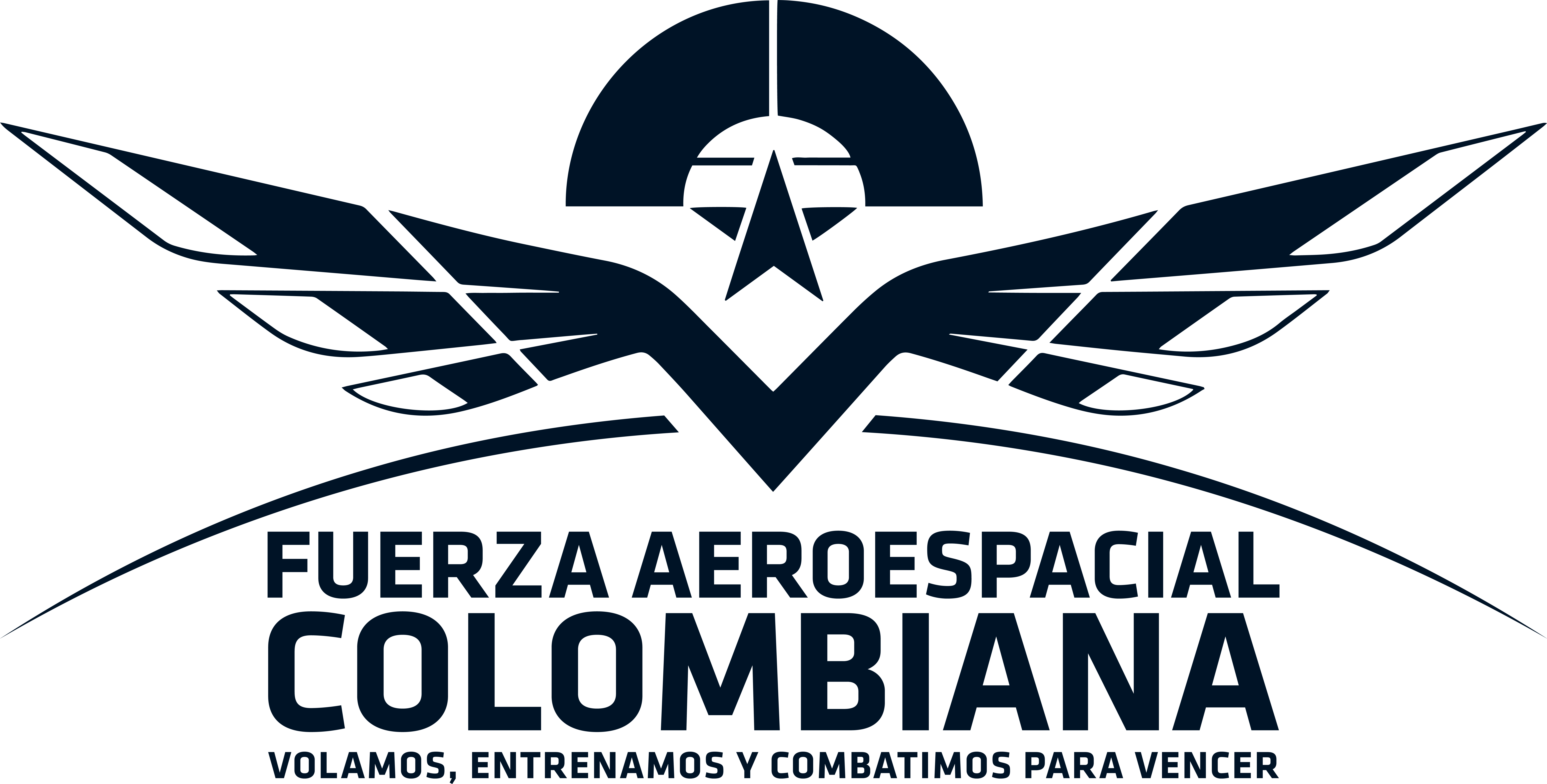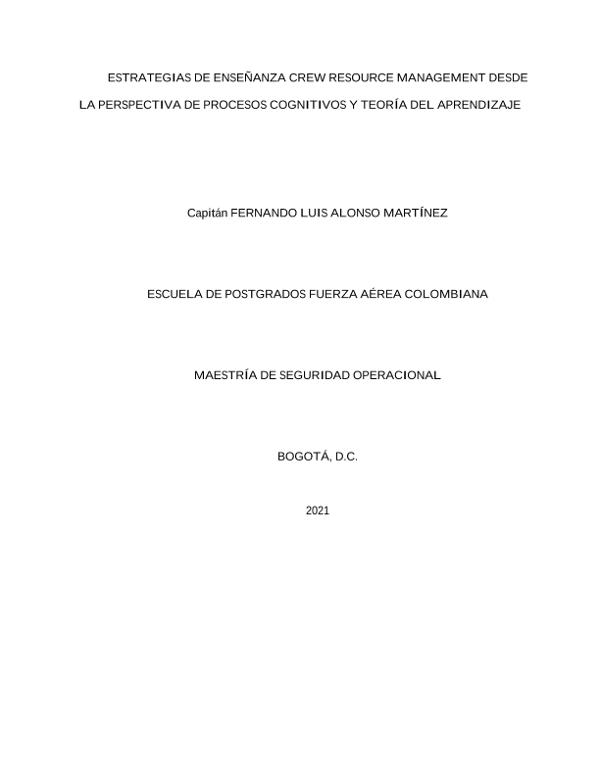| dc.contributor.author | Alonso Martinez, Fernando Luis | |
| dc.date.accessioned | 2022-03-30T14:51:13Z | |
| dc.date.available | 2022-03-30T14:51:13Z | |
| dc.date.issued | 2022-03-02 | |
| dc.identifier.citation | Alonso, F. (2021). Estrategias de enseñanza Crew Resource Management desde la perspectiva de procesos cognitivos y teoría del aprendizaje. Escuela de Postgrados Fuerza Aérea Colombiana. | spa |
| dc.identifier.uri | https://hdl.handle.net/20.500.12963/835 | |
| dc.format.extent | 103 páginas. | |
| dc.format.mimetype | application/pdf | spa |
| dc.language.iso | eng | spa |
| dc.rights.uri | http://creativecommons.org/publicdomain/zero/1.0/ | * |
| dc.title | ESTRATEGIAS DE ENSEÑANZA CREW RESOURCE MANAGEMENT DESDE LA PERSPECTIVA DE PROCESOS COGNITIVOS Y TEORÍA DEL APRENDIZAJE | spa |
| dcterms.references | Baddeley, A. (1998). HUman memory: Theory and practice. Allyn y Bacon. | spa |
| dcterms.references | Bales, R. (1950). Interaction process analysis; a method for the study of small groups. s/e. | spa |
| dcterms.references | Broadbent, D. (1958). Perception and communication. Pergamon. | spa |
| dcterms.references | Chidester, T. (1990). Trends and individual differences in response to short-haul flight operations. Aviation, Space, and Environmental Medicine, 61(2), 132-138. DOI: https://pubmed.ncbi.nlm.nih.gov/2310360/. | spa |
| dcterms.references | Chidester, T. R., Kanki, B. G., Foushee, C. H., Dickinson, C. L., & Bowles, S. V. (1990). Personality factors inflight operations: Vol. 1. Leader characteristics and crew performance in full-mission air transport simulation (NASA Technical Memorandum 102259). Moffet Field, CA: NASA-Ames Research Center. | spa |
| dcterms.references | Cidester, T., Kanki, B., Foushee, C., Dickinson, C., & Bowles, S. (1990). Personalyti Factors in Flight Operations: Vol I. Leader Characteristics and Crew Performance in a Full Mission Air Transport Simulation. NASA. | spa |
| dcterms.references | Flanagan, J. C. (1954). The critical incident technique. . Psychological Bulletin. | spa |
| dcterms.references | Foushee, C., & Helmreich, R. (1988). Human Factors in Aviation. Academic Press. | spa |
| dcterms.references | Gann, E. (1961). Fate is the hunter. Simon and Schuter Paperbacks. | spa |
| dcterms.references | Grabe, M. (1986). Atentional Processes in education. Academic Press. | spa |
| dcterms.references | Grabe, M. (1986). Atentional Processes in education. Academic Press. | spa |
| dcterms.references | Groome, D. (2014). An Introduction to Cognitivie Psychology. Psychology Press. | spa |
| dcterms.references | Gupta, P., & Cohen, N. (2002). Theoretical and computational analysis of skill learning, repetition priming, and procedural memory. Psychological Review, 109(2), 401-448. | spa |
| dcterms.references | Hackman, j. R., & Helmreich, R. (1984). Assessing the Behavior and Performance of Teams in organizatión: The case of air transport Crews. New Haven: Research program on group effectiveness Yale school of organization and management. | spa |
| dcterms.references | Helmreich, R. (1997). The University of Texas at Austin. Culture, error and CRM. | spa |
| dcterms.references | Helmreich, R. L., & Merrit, A. C. (1997). Culture, Error, and Crew Resource Management. Austin: University of Texas at Austin. | spa |
| dcterms.references | Helmreich, R., Klinect, J., & Wilhelm, J. (1999). Models of Threat Error and CRM in Flight Operations. University of Texas Team Research Project. | spa |
| dcterms.references | Helmreich, R., Wilhelm, J., Kello, J., Taggart, W., & Butler, R. (1991). Reinforcing and evaluating crew resource management: Evaluator/LOS instructor reference. NASA/University of Texas Technical Manual. | spa |
| dcterms.references | Hernández, R. (2010). Metodología de la Investigación. Mc Graw-Hill. | spa |
| dcterms.references | ICAO. (1989). Flight Crew Training: Cockpit Resource Management (CRM) and Line Oriented Flight Training. Civil Aviation Authority. | spa |
| dcterms.references | Jensen, E. (2005). Teaching with the brain in mind. Association for Supervision and Curriculum Development. | spa |
| dcterms.references | Kahneman, D. (2011). Thinking fast and slow. New York: Farrar, Straus and Giroux. | spa |
| dcterms.references | Kanfer, R., & Ackerman, P. (1989). Motivation and cognitive abilities: and integrative/aptitud-treatment interaction approach to skill acquisition. Journal of Applied Psychology, 74(4), 657-690. DOI: https://doi.org/10.1037/0021-9010.74.4.657. | spa |
| dcterms.references | Kanki, B., Anca, J., & Chidester, T. (2019). Crew resource Management. Academic Press. | spa |
| dcterms.references | Lauber, J. (1984). Resource Management in the Cockpit. s/e. | spa |
| dcterms.references | Lauber, J., & Foushee, C. (1981). Guidelines for Line-Oriented Fight Training. NASA Ames Research Center. | spa |
| dcterms.references | Mayer, R. (1996). Learners as information proccesors: Legacies and limitations of educational psychology´s second metaphor. Educational Psychologist. | spa |
| dcterms.references | Miller, G. (1956). The magical number seven, plus or minus two: Some limits on our capacity for processing information. s/e. | spa |
| dcterms.references | Nagel, E., & Wiener, D. (1988). Human Factor in Aviation. Academic Press. | spa |
| dcterms.references | National Aeronautics and Space Administration. (1979). Resource Management On The Flight deck. Resource Management On The Flight deck (p. 247). San Francisco, California : NASA. | spa |
| dcterms.references | National Research Council. (1989). Human Factors Research and Nuclear Safety. Ntional Academy Press. | spa |
| dcterms.references | Neisser, U. (1967). Cognitive psychology. Prentice Hall. | spa |
| dcterms.references | Penelope Jaime Santana, Y. A. (2007). Clima y cultura organizacional: dos constructos para explicar un mismo fenomeno? España. | spa |
| dcterms.references | Pintrich, P. R., Kosma, R. B., & McKeachi, W. J. (1986). Instructional Psychology. Annual Review of Psychology. | spa |
| dcterms.references | Purves, D., Augustine, G., Fitzpatrick, D., Hall, W., Lamantia, A., Mcnamara, J., et al. (2008). Neurociencia. Panamericana. | spa |
| dcterms.references | Schunk, D. (1991). Self-efficacy and academic motivation. Educational Psychologist. | spa |
| dcterms.references | Schunk, D. (2012). Teorias del Aprendizaje. Pearson. | spa |
| dcterms.references | SKYbrary. (2020). Home. https://www.skybrary.aero/index.php/Crew_Resource_Management_(CRM) | spa |
| dcterms.references | Smith, H. (1979). A Simulator Study of the Interaction of Pilot Workload with errors, vigilance, and decisions. National Aeronautics and Space Administration. | spa |
| dcterms.references | Snow, R. E. (1989). Toward assessment of cognitive and conative structures in learning. Educational Researcher, 8-14. | spa |
| dcterms.references | Treisman, A. (1964). Verbal cues, lenguaje, and meaning in selective attention. American Journal of Psychology, 206, 206-219. | spa |
| dcterms.references | Unsworth, N., & Engle, R. (2007). The nature of individual differences in working memory capacity: Active maintenance in primary memory and controlled search from secondary memory. s/e. | spa |
| dcterms.references | Wolfe, P. (2001). Brain Matters: Tanslating Research into Classroom Practice. Association for Supervision and Curriculum Development. | spa |
| dc.identifier.instname | Escuela de Postgrados de la Fuerza Aérea Colombiana | spa |
| dc.identifier.reponame | Repositorio EPFAC | spa |
| dc.rights.accessrights | info:eu-repo/semantics/openAccess | spa |
| dc.rights.cc | CC0 1.0 Universal | * |
| dc.subject.keywords | Crew Resource Management | spa |
| dc.type.driver | info:eu-repo/semantics/masterThesis | spa |
| dc.type.hasversion | info:eu-repo/semantics/draft | spa |
| dc.type.spa | Tesis de maestría | spa |
| datacite.rights | http://purl.org/coar/access_right/c_abf2 | spa |
| oaire.resourcetype | http://purl.org/coar/resource_type/c_bdcc | spa |
| oaire.version | http://purl.org/coar/version/c_b1a7d7d4d402bcce | spa |
| thesis.degree.discipline | Maestría en Seguridad Operacional | spa |
| thesis.degree.grantor | Escuela de Postgrados de la Fuerza Aérea Colombiana | spa |
| thesis.degree.level | Tesis maestría | spa |
| thesis.degree.name | Maestría en Seguridad Operacional | spa |



